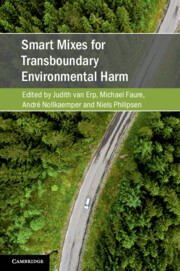Book contents
- Smart Mixes for Transboundary Environmental Harm
- Cambridge Studies on Environment, Energy and Natural Resources Governance
- Smart Mixes for Transboundary Environmental Harm
- Copyright page
- Contents
- Figures
- Tables
- Contributors
- Acknowledgments
- Abbreviations
- Part I Conceptual Approaches to Smart Mixes
- 1 Introduction
- 2 ‘Smart’ Public-Private Complementarities in the Transnational Regulatory and Enforcement Space
- 3 Smart Mixes and the Challenge of Complexity
- 4 Smart (and Not-So-Smart) Mixes of New Environmental Policy Instruments
- Part II Fisheries and Forestry
- Part III Climate Change and Oil
- Part IV Concluding Remarks
- References
2 - ‘Smart’ Public-Private Complementarities in the Transnational Regulatory and Enforcement Space
from Part I - Conceptual Approaches to Smart Mixes
Published online by Cambridge University Press: 15 March 2019
- Smart Mixes for Transboundary Environmental Harm
- Cambridge Studies on Environment, Energy and Natural Resources Governance
- Smart Mixes for Transboundary Environmental Harm
- Copyright page
- Contents
- Figures
- Tables
- Contributors
- Acknowledgments
- Abbreviations
- Part I Conceptual Approaches to Smart Mixes
- 1 Introduction
- 2 ‘Smart’ Public-Private Complementarities in the Transnational Regulatory and Enforcement Space
- 3 Smart Mixes and the Challenge of Complexity
- 4 Smart (and Not-So-Smart) Mixes of New Environmental Policy Instruments
- Part II Fisheries and Forestry
- Part III Climate Change and Oil
- Part IV Concluding Remarks
- References
Summary
- Type
- Chapter
- Information
- Smart Mixes for Transboundary Environmental Harm , pp. 25 - 48Publisher: Cambridge University PressPrint publication year: 2019
References
- 2
- Cited by



